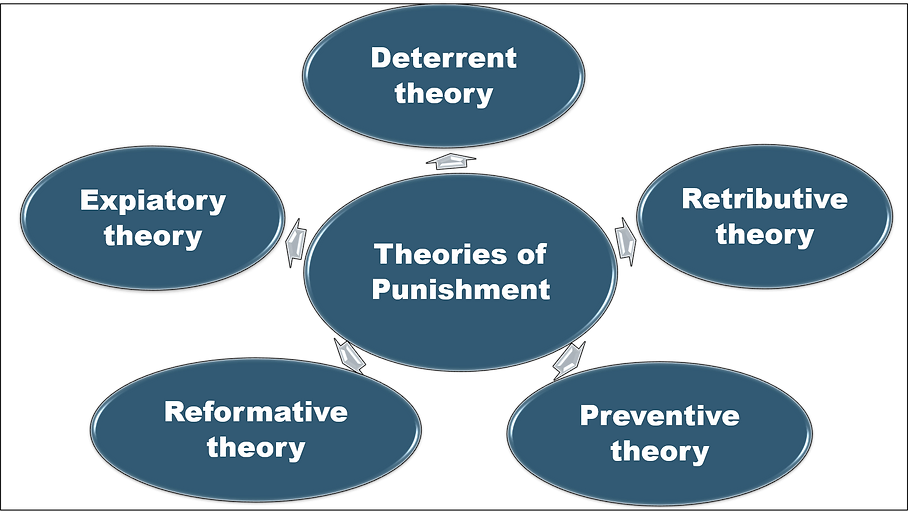What is Punishment?
Punishment is a fundamental concept in criminal law, serving as a consequence for those who violate legal norms. It’s not just about imposing a penalty; it’s a mechanism to maintain order and justice within society. Punishment involves depriving the offender of certain rights as a response to their wrongdoing, with the aim of discouraging both the individual and others from engaging in similar conduct.

As highlighted by ancient texts like the Manu Smriti, punishment is essential for social order. The idea is that penalties keep people in check, ensuring they adhere to the laws that govern society. Without punishment, the rule of law would be ineffective, and societal justice would be compromised.
Theories of Punishment
Over time, legal scholars and philosophers have developed various theories to explain the purpose and justification of punishment. Each theory offers a different perspective on how punishment should be applied and what its ultimate goal should be.
Also Read: Legal Status of Minor in India
1. Deterrent Theory: Preventing Future Crimes
The Deterrent Theory of Punishment is based on the idea that the fear of punishment will discourage people from committing crimes. The central premise is to make an example out of offenders, thus sending a message to the broader society that crime does not pay.
This theory is often summarized by the phrase, “You are punished not for stealing a horse, but so that no other horse will be stolen.” The idea is to create a psychological barrier, deterring both the offender and others from engaging in criminal behaviour. This theory emphasizes the severity, certainty, and swiftness of punishment as key elements in preventing crime.
Critics, however, argue that deterrence does not address the root causes of criminal behaviour and may be less effective in cases where individuals do not weigh the consequences of their actions.
2. Retributive Theory: Justice Through Retaliation
Retributive theory is one of the oldest and most straightforward theories of punishment. It operates on the principle of “an eye for an eye,” meaning that the punishment should fit the crime. The idea is that offenders deserve to suffer in proportion to the harm they have caused.
Proponents of this theory argue that it upholds justice by ensuring that criminals receive their just deserts. The focus is not on preventing future crimes but on ensuring that justice is served for the wrongdoing that has already occurred.
However, this theory has been criticized for its potential to promote a cycle of violence and for not considering the potential for rehabilitation.
3. Preventive Theory: Incapacitating the Offender
The Preventive Theory of punishment aims to prevent future crimes by incapacitating the offender. This can be done through imprisonment, where the offender is isolated from society, or in extreme cases, through the death penalty.
This theory is grounded in the belief that some individuals pose a continuing threat to society and must be restrained from committing further crimes. By removing the offender’s ability to harm others, society is protected from future harm.
While this theory is effective in preventing repeat offences, it does not address the underlying causes of criminal behaviour or offer a path to rehabilitation.
4. Reformative Theory: Changing the Offender
The Reformative Theory of punishment takes a more humane approach, focusing on the rehabilitation of the offender rather than simply punishing them. The goal is to reform the individual’s behaviour so they can return to society as a law-abiding citizen.
This theory is supported by the belief that everyone is capable of change. By addressing the factors that led to criminal behaviour—such as poverty, lack of education, or mental health issues—this theory seeks to reintegrate the offender into society in a positive way.
Critics argue that this approach may be too lenient, particularly in cases involving serious crimes, and that it may not always be effective in changing deeply ingrained behaviours.
5. Expiatory Theory: Atonement Through Repentance
The Expiatory Theory of punishment is rooted in the idea of atonement. It holds that offenders should be allowed to make amends for their crimes, often through acts of repentance or restitution. This theory is less concerned with the punitive aspects of punishment and more focused on moral and ethical redemption.
In ancient societies, this theory was closely tied to religious beliefs, where offenders were encouraged to seek forgiveness through acts of penance. While this approach can promote reconciliation, it is often seen as too idealistic and impractical, especially in modern legal systems where the focus is on protecting public safety.
Conclusion
Theories of punishment provide a framework for understanding how societies respond to crime. While each theory offers valuable insights, none is without its limitations. A balanced criminal justice system often incorporates elements from multiple theories to address the complexities of human behaviour and maintain social order. Whether through deterrence, retribution, prevention, reformation, or expiation, the ultimate goal remains the same: to uphold justice and ensure the safety and well-being of society.
FAQs
1. What is the primary goal of deterrent theory?
The primary goal of the deterrent theory is to prevent crime by instilling fear of punishment, thereby discouraging both the offender and others from engaging in criminal activities.
2. How does retributive theory differ from reformative theory?
Retributive theory focuses on punishing the offender in proportion to the crime, while reformative theory emphasizes rehabilitating the offender to reintegrate them into society.
3. Why is the preventive theory considered effective in some cases?
The preventive theory is considered effective because it physically incapacitates the offender, preventing them from committing further crimes and protecting society from potential harm.
Also Read: Legal Status of a Dead Person